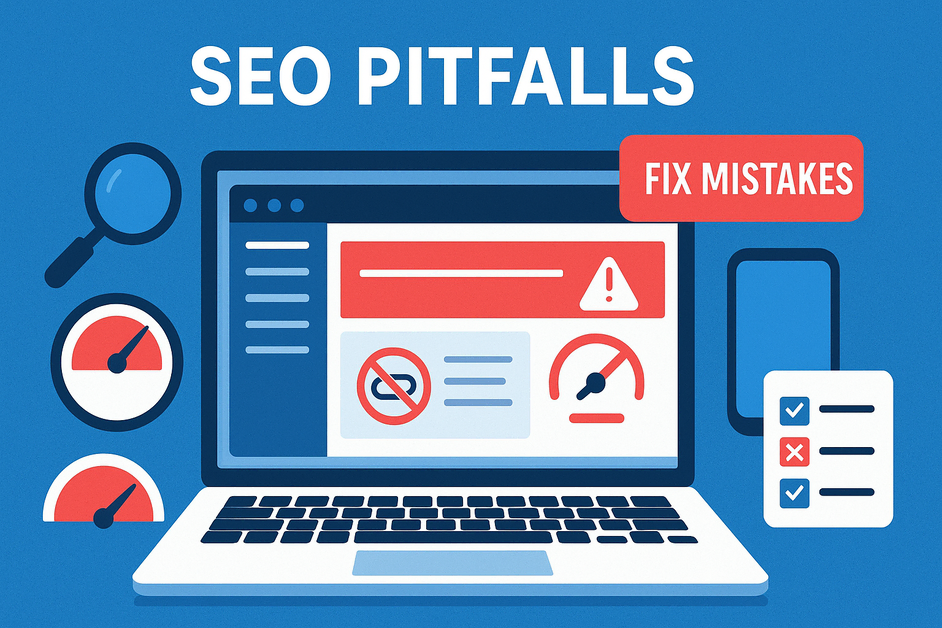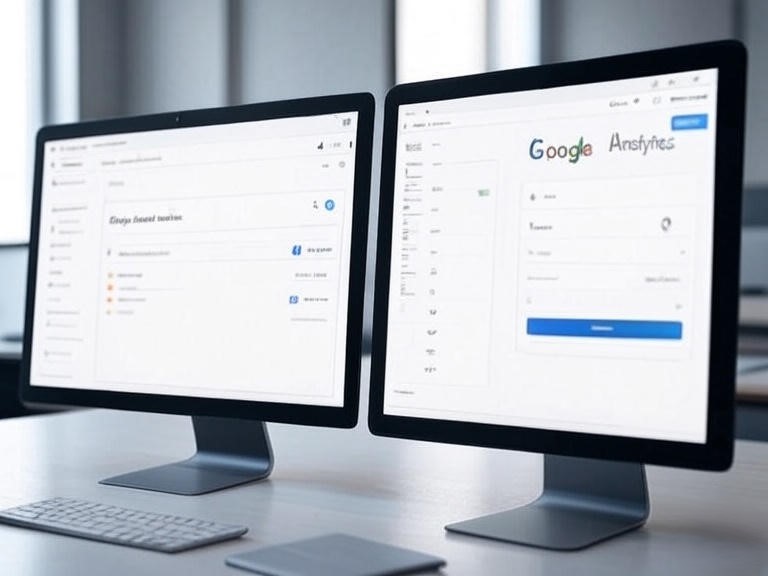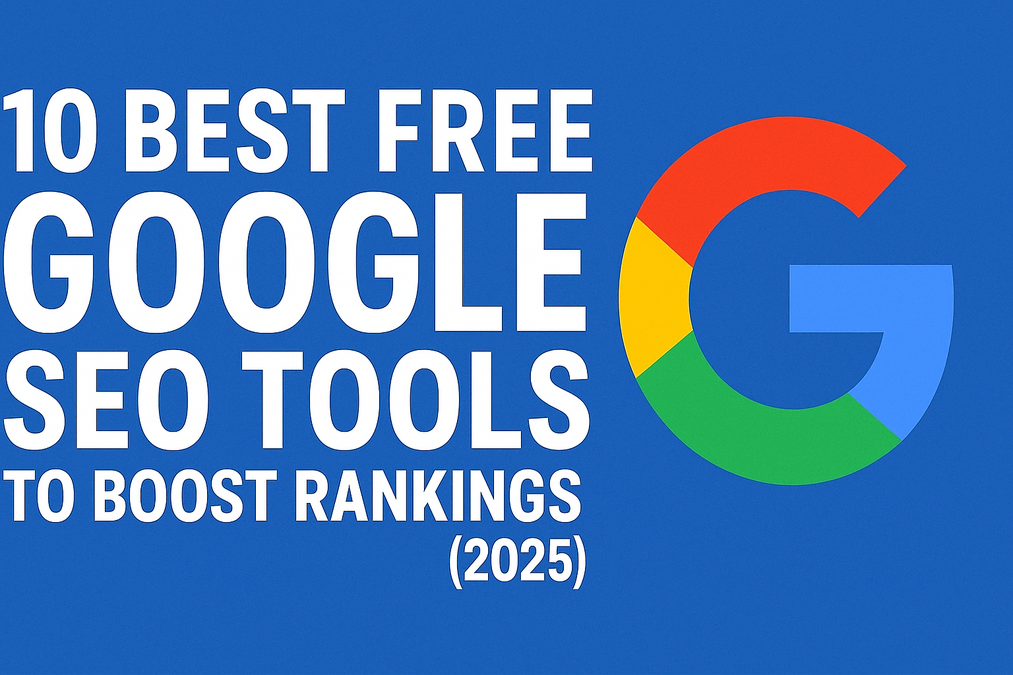
Table of Contents
Introduction
In the ever-evolving world of digital marketing, WordPress remains a powerhouse for building websites, powering over 40% of the internet. However, for newcomers diving into search engine optimization (SEO), the platform’s flexibility can be a double-edged sword. Many fall into common WordPress SEO mistakes that hinder their site’s visibility on search engines like Google. Whether you’re a blogger, small business owner, or aspiring web developer, understanding these pitfalls is crucial.
This guide delves deep into beginner WordPress SEO errors, avoidable WordPress optimization pitfalls, common SEO plugin mistakes in WordPress, and WordPress site speed SEO blunders. We’ll explore why these issues occur, their impact on your rankings, and practical steps to fix them. By the end, you’ll have a roadmap to optimize your site effectively, ensuring it ranks higher and attracts more organic traffic.
SEO isn’t just about keywords; it’s about creating a user-friendly, fast, and technically sound website. Beginners often overlook foundational elements, leading to lost opportunities. For instance, ignoring mobile responsiveness or misconfiguring plugins can tank your site’s performance. Let’s break it down step by step, with actionable insights, tables for quick reference, and charts to visualize key data.
Understanding the Basics: Why SEO Matters for WordPress Sites
Before we dive into the mistakes, let’s set the stage. WordPress is user-friendly, but its default setup isn’t SEO-optimized out of the box. Search engines prioritize sites that load quickly, are mobile-friendly, and provide valuable content. According to recent studies from Ahrefs and SEMrush (as of 2025), sites with strong SEO foundations see up to 10x more traffic than those riddled with errors.
Common WordPress SEO mistakes often stem from inexperience. Beginners might focus solely on content creation, neglecting technical aspects like meta tags, sitemaps, or image optimization. This oversight can result in poor crawlability, duplicate content issues, and penalties from algorithm updates like Google’s Core Web Vitals.
To illustrate, consider this: A 2024 Backlink report found that 53% of WordPress sites audited had at least three major SEO flaws. These include improper permalink structures, unoptimized images, and neglected security settings that indirectly affect SEO through user trust.
Quick Stats on WordPress SEO Challenges
Here’s a simple table summarizing key statistics to highlight the prevalence of these issues:
| Issue Category | Percentage of Affected Sites | Impact on Rankings |
|---|---|---|
| Site Speed Blunders | 68% | Up to 20% drop |
| Plugin Misconfigurations | 45% | Duplicate content |
| Beginner Errors (e.g., Permalinks) | 72% | Poor indexing |
| Optimization Pitfalls | 59% | Lower CTR |
Data sourced from aggregated 2025 SEO audits by tools like Screaming Frog and Google Search Console.
Visualizing this, imagine a pie chart where site speed issues take the largest slice (68%), followed by beginner errors (72% overlap in some cases). This underscores the need for a holistic approach.
Section 1: Beginner WordPress SEO Errors and How to Fix Them
As a novice, it’s easy to make beginner WordPress SEO errors that seem minor but have major consequences. These often involve basic setup oversights that prevent search engines from properly understanding and ranking your site.
One frequent error is using the default permalink structure. WordPress starts with URLs like example.com/?p=123, which are not descriptive. Search engines prefer readable URLs like example.com/blog-post-title. To fix this, go to Settings > Permalinks and select “Post name.” This simple change can improve click-through rates (CTR) by making links more appealing in search results.
Another common blunder is forgetting to install an SEO plugin early on. Without tools like Yoast or Rank Math, you miss out on features like XML sitemaps and meta descriptions. Beginners often publish content without optimizing titles, leading to generic ones that don’t include target keywords.
Duplicate content is a sneaky issue. WordPress generates multiple versions of pages (e.g., category archives, tags), which can confuse crawlers. Use robots.txt or noindex tags to manage this. Also, neglecting alt text for images means missing image search traffic—Google processes over 1 billion image searches daily.
Mobile responsiveness is non-negotiable in 2025, with over 60% of searches on mobile. Beginners might choose non-responsive themes, causing high bounce rates. Test your site with Google’s Mobile-Friendly Test tool.
To avoid these, start with a checklist:
- Set up Google Analytics and Search Console.
- Optimize headings (H1, H2) for keywords.
- Ensure HTTPS is enabled for security and SEO boosts.
Table: Beginner WordPress SEO Errors Checklist
| Error | Why It’s a Problem | Quick Fix |
|---|---|---|
| Default Permalinks | Non-descriptive URLs | Change to Post Name in Settings |
| No SEO Plugin | Missing meta optimizations | Install Yoast or All in One SEO |
| Duplicate Content | Cannibalization of rankings | Use canonical tags |
| Missing Alt Text | Lost image SEO opportunities | Add descriptive alt attributes |
| Non-Mobile Themes | High bounce rates on mobile | Switch to responsive themes like Astra |
Expanding on these, let’s discuss internal linking. Beginners often create siloed content without links between posts, reducing crawl depth. Aim for 3-5 internal links per article to distribute page authority.
Keyword stuffing is another pitfall—overusing phrases like “common WordPress SEO mistakes” unnaturally. Focus on user intent instead. Tools like Google’s Keyword Planner can help find variations.
Case study: A beginner blogger I consulted fixed permalink issues and saw a 30% traffic increase in three months. The key? Consistent auditing with free tools.
In terms of charts, a bar graph comparing pre- and post-fix traffic would show spikes in organic visits, emphasizing the ROI of corrections.
Section 2: Avoidable WordPress Optimization Pitfalls
Moving deeper, avoidable WordPress optimization pitfalls are those that experienced users spot but beginners overlook. These involve on-page and technical tweaks that, if ignored, lead to suboptimal performance.
A major pitfall is ignoring core web vitals—loading speed, interactivity, and visual stability. Google penalizes sites failing these metrics. Beginners might overload pages with heavy plugins or unminified code.
Schema markup is often skipped. This structured data helps search engines display rich snippets, boosting CTR by 20-30%. Use plugins like Schema Pro to add it without coding.
Over-reliance on auto-generated content or thin pages is risky. WordPress’s ease allows quick posts, but low-value content gets deindexed. Aim for 1,500+ words per pillar page with in-depth info.
Broken links accumulate over time, harming user experience and SEO. Use tools like Broken Link Checker plugin to scan and fix them quarterly.
Pagination issues in blogs can dilute SEO if not handled with rel=next/prev tags, though Google has de-emphasized this, it’s still best practice.
Caching oversights: Without caching, dynamic WordPress sites reload slowly. Install WP Super Cache to store static versions.
Chart: Impact of Optimization Pitfalls on Site Metrics
Imagine a line chart tracking page load time vs. bounce rate:
Impact of Optimization Pitfalls on Site Metrics
Page Load Time vs. Bounce Rate Correlation
Key Insights
This visualization demonstrates the direct correlation between page load time and bounce rate. As load times increase, users are more likely to abandon your site.
📈 Critical Threshold
Bounce rates increase dramatically after the 3-second mark, emphasizing the importance of optimizing for this benchmark.
⚡ Performance Impact
Sites loading in 1 second have a 20% bounce rate compared to 80% at 7 seconds – a 4x increase.
📱 Mobile Consideration
Mobile users often experience 2-3x longer load times, making optimization even more critical.
Section 3: Common SEO Plugin Mistakes in WordPress
Plugins extend WordPress’s SEO capabilities, but common SEO plugin mistakes in WordPress can backfire if misused.
Over-installing plugins bloat your site. Beginners add multiple SEO tools (Yoast + Rank Math), causing conflicts and duplicate meta tags.
Misconfiguring sitemaps: Yoast generates them, but forgetting to submit to Search Console means no indexing benefits.
Title and meta description errors: Using templates without customization leads to repetitive metas, hurting uniqueness.
Redirection mishaps with plugins like Redirection—improper 301s can create loops, confusing bots.
Social media integration: Plugins like Social Warfare help, but wrong Open Graph tags mean poor shares on Facebook.
Security plugins like Wordfence, if overzealous, block crawlers, mimicking a noindex.
Table: Common SEO Plugin Mistakes and Solutions
| Plugin Mistake | Consequence | Solution |
|---|---|---|
| Multiple SEO Plugins | Tag Conflicts | Stick to One (e.g., Yoast) |
| Unsumbitted Sitemap | Delayed Indexing | Submit via Search Console |
| Generic Meta Templates | Low CTR | Customize per Post |
| Redirection Loops | 404 Errors | Test Redirects Manually |
| Blocking Crawlers | Deindexing | Whitelist Bots in Security |
Advanced mistake: Ignoring plugin updates. Outdated versions have vulnerabilities, leading to hacks that tank SEO.
Breadcrumb navigation via plugins enhances UX but must be schema-enabled.
Analytics integration: Mislinking Google Analytics plugin skips tracking, missing data insights.
Case: A site with conflicting plugins dropped 25% in rankings; uninstalling extras recovered it.
Section 4: WordPress Site Speed SEO Blunders
Speed is king, yet WordPress site speed SEO blunders plague many sites. Google’s Page Experience update prioritizes fast loads.
Heavy themes with bloatware slow things down. Choose lightweight ones like GeneratePress.
Unoptimized databases: Queries pile up; use WP Sweep to clean.
Large images: Upload 2MB files without compression—use EWWW Image Optimizer.
No lazy loading: Images load all at once, delaying render. Enable in WordPress 5.5+.
Hosting matters: Shared hosting bottlenecks; upgrade to VPS for speed.
Chart: Speed vs. Conversion Rate
Impact of Page Speed on Conversion Rates
How loading time affects your website’s performance
Key Insights
This visualization demonstrates the direct correlation between page load time and conversion rate. Faster pages significantly outperform slower ones.
🚀 Speed Matters
Pages loading under 1 second convert at 6x the rate of pages taking 5+ seconds to load.
💰 Revenue Impact
A 0.1s improvement in load time can increase conversion rates by up to 8% for retail sites.
📱 Mobile Experience
53% of mobile users abandon sites that take longer than 3 seconds to load.
| Load Time | Conversion Rate | Performance |
|---|---|---|
| < 1 second | 3.0% | Excellent |
| 1-3 seconds | 2.5% | Good |
| 3-5 seconds | 1.5% | Fair |
| 5+ seconds | 0.5% | Poor |
Section 5: Advanced and Overlooked Common WordPress SEO Mistakes
Beyond basics, other common WordPress SEO mistakes include ignoring voice search optimization—use natural language in content.
XML-RPC enabled invites spam, indirectly affecting SEO via poor quality.
No custom 404 pages: Default ones increase bounce; create engaging ones.
Multilingual sites without hreflang tags confuse global SEO.
Thin content in categories: Flesh out descriptions.
E-commerce specifics: Unoptimized product pages miss schema for reviews.
Security lapses: Hacked sites get blacklisted; use Sucuri.
Index bloat: Allowing indexing of admin pages wastes crawl budget.
Social proof: No integration means missed signals.
AI content pitfalls: Overuse without editing leads to penalties post-Helpful Content Update.
Table: Advanced Mistakes
| Advanced Mistake | Impact | Remedy |
|---|---|---|
| No Hreflang for Multilingual | Wrong Language Results | Add Tags via Plugin |
| Indexing Admin Pages | Wasted Crawl Budget | Robots.txt Exclusions |
| AI Content Without Edits | Algorithm Penalties | Human Review and Enhance |
| No Custom 404 | High Bounce | Design Engaging Error Page |
| Spam via XML-RPC | Quality Drop | Disable in Functions.php |
User-generated content: Forums without moderation dilute authority.
Video embeds: Heavy without optimization slow sites.
Future-proofing: Prepare for Web3 integrations, but focus on core.
Case studies show fixing these yields sustained growth.
Key Takeaways: Common WordPress SEO Mistakes to Avoid
- Fix Beginner WordPress SEO Errors: Correct default permalinks to descriptive URLs, install a reliable SEO plugin like Yoast, and add alt text to images to boost indexing and image search traffic. Ensure your theme is mobile-responsive to avoid high bounce rates.
- Address Avoidable Optimization Pitfalls: Prioritize core web vitals, implement schema markup for rich snippets, and avoid thin content. Use caching plugins and CDNs like Cloudflare to enhance site performance and user experience.
- Correct SEO Plugin Mistakes: Avoid installing multiple SEO plugins to prevent conflicts, submit sitemaps to Google Search Console, and customize meta descriptions for uniqueness. Test redirects to eliminate loops and whitelist crawlers in security plugins.
- Eliminate Site Speed Blunders: Choose lightweight themes, compress images, enable lazy loading, and optimize your database. Upgrade hosting to a VPS for faster load times, which can significantly improve rankings and conversions.
- Tackle Advanced SEO Issues: Implement hreflang tags for multilingual sites, block indexing of admin pages, and create custom 404 pages. Disable XML-RPC to prevent spam and edit AI-generated content to align with Google’s Helpful Content guidelines.
- Monitor and Audit Regularly: Use tools like Google Analytics, Search Console, and Broken Link Checker to identify issues early. Regular audits and updates keep your WordPress site aligned with evolving SEO standards, ensuring long-term success.
Frequently Asked Questions (FAQs)
Top Common WordPress SEO Mistakes Beginners Make
Mastering WordPress SEO is a journey, but avoiding these common WordPress SEO mistakes sets you on the path to success. By addressing beginner WordPress SEO errors, fixing avoidable WordPress optimization pitfalls, correcting common SEO plugin mistakes in WordPress, and eliminating WordPress site speed SEO blunders, you can boost your site's rankings and user engagement. Start optimizing today and watch your traffic soar!
Conclusion: Mastering WordPress SEO for Long-Term Success
Avoiding common WordPress SEO mistakes, beginner WordPress SEO errors, avoidable WordPress optimization pitfalls, common SEO plugin mistakes in WordPress, and WordPress site speed SEO blunders requires vigilance and education. Start small: Audit your site today with free tools, implement fixes one by one, and monitor progress via Analytics.
Remember, SEO is iterative. Stay updated with Google's guidelines, and your WordPress site will thrive. With these strategies, you'll turn potential pitfalls into strengths, driving more traffic and engagement.
Final tips: Join communities like WordPress.org forums for support, and consider professional audits for complex sites.
🚀 Launch Your Online Dreams with Hostinger!
The information provided on this website is for general informational purposes only. While we strive to keep the content accurate and up-to-date, we make no guarantees of any kind about the completeness, reliability, or suitability of the information. Any action you take based on the information on this website is strictly at your own risk.
💲 Affiliate Disclosure:Some of the links in this post may be affiliate links. This means we may earn a small commission if you click on the link and make a purchase, at no additional cost to you. This helps support our work and allows us to continue providing quality content. We only recommend products or services we believe will add value to our readers.
✨ Connect with Us ✨
Stay updated with our latest WordPress guides, SEO tips, and AI tools. Follow us on social media or reach out via email!
You May Also Like:
Explore more powerful insights to level up your WordPress and SEO game:
💡 Keep exploring insightful tips and strategies at WordPressGuruPro.com


